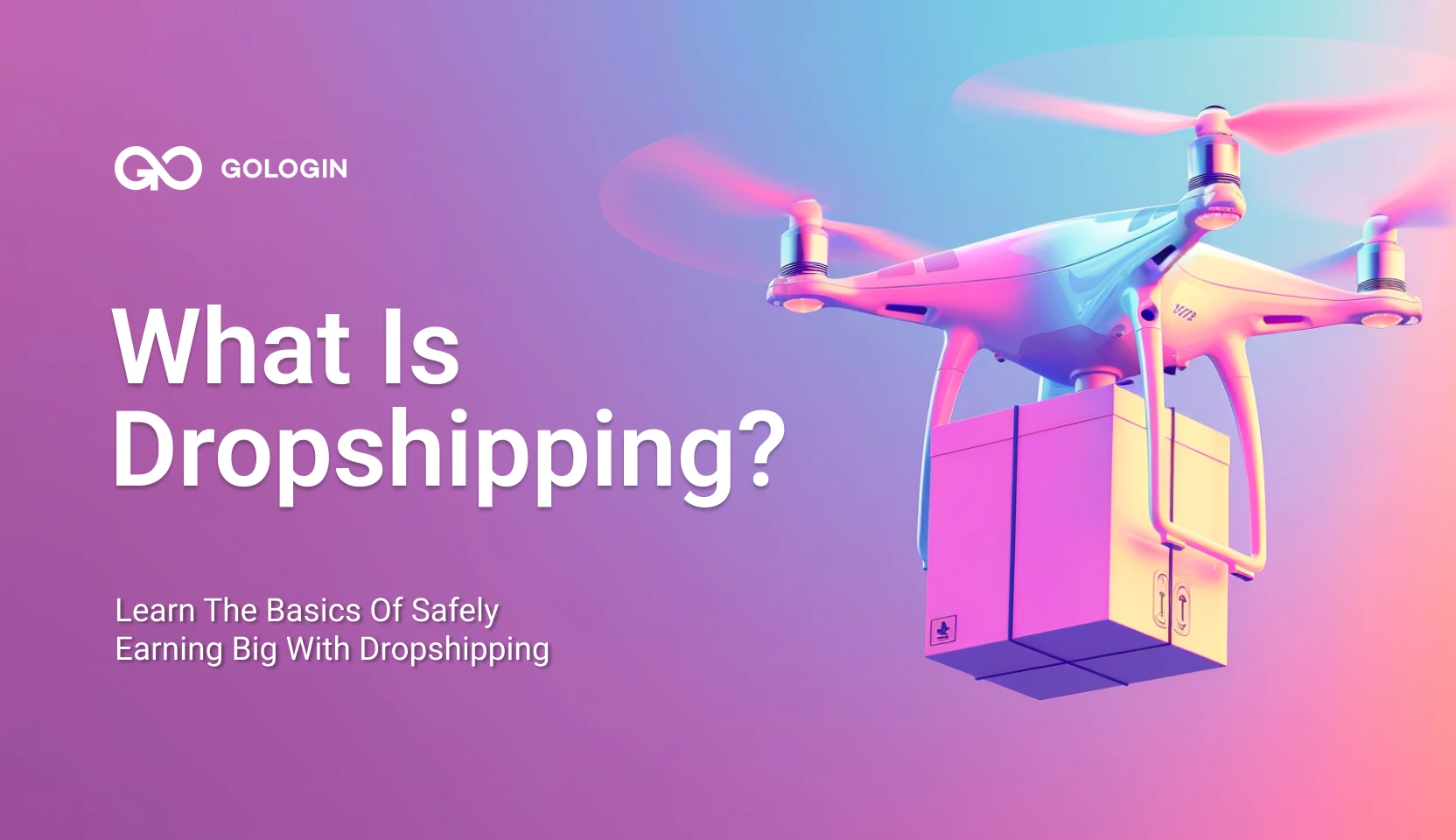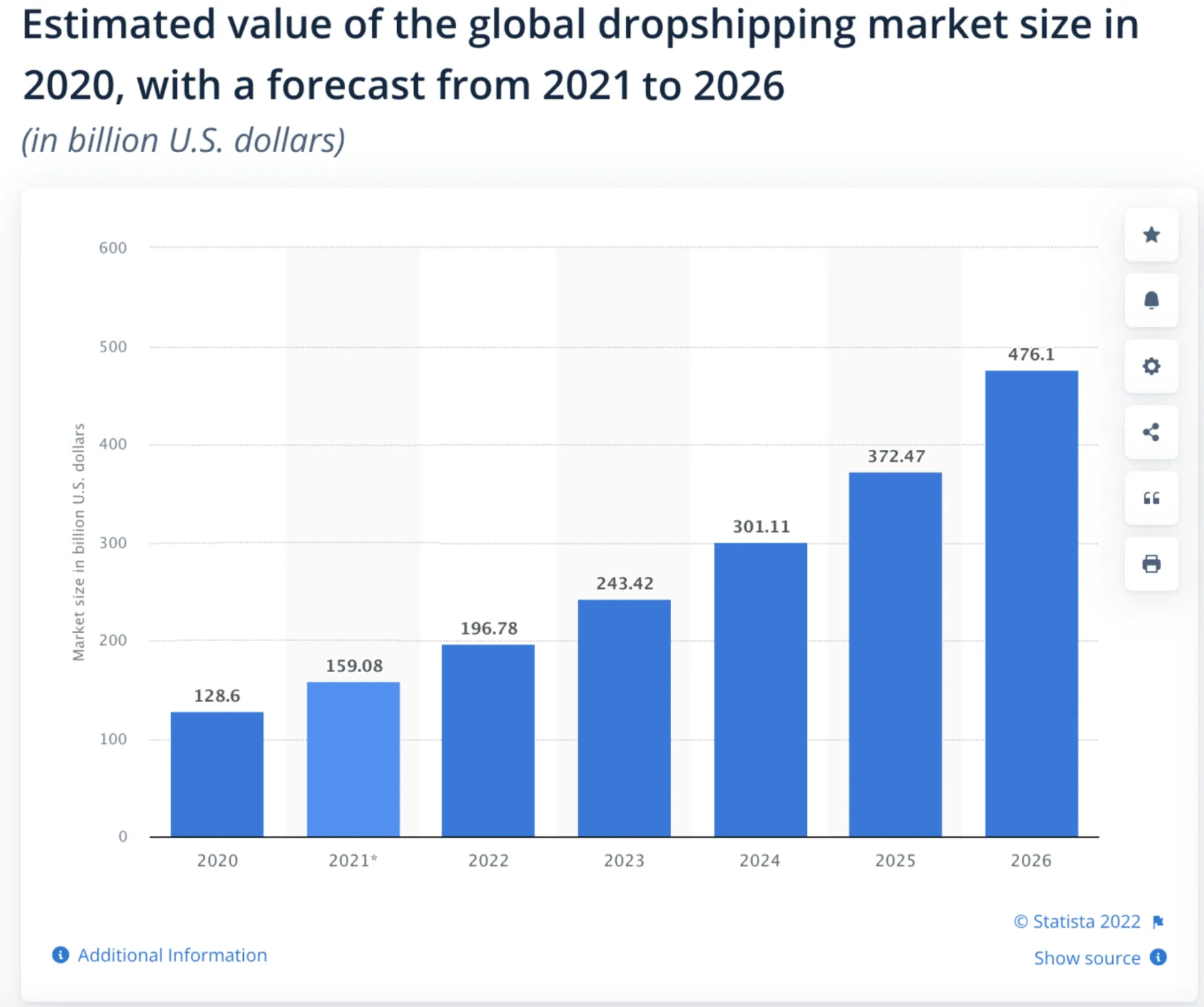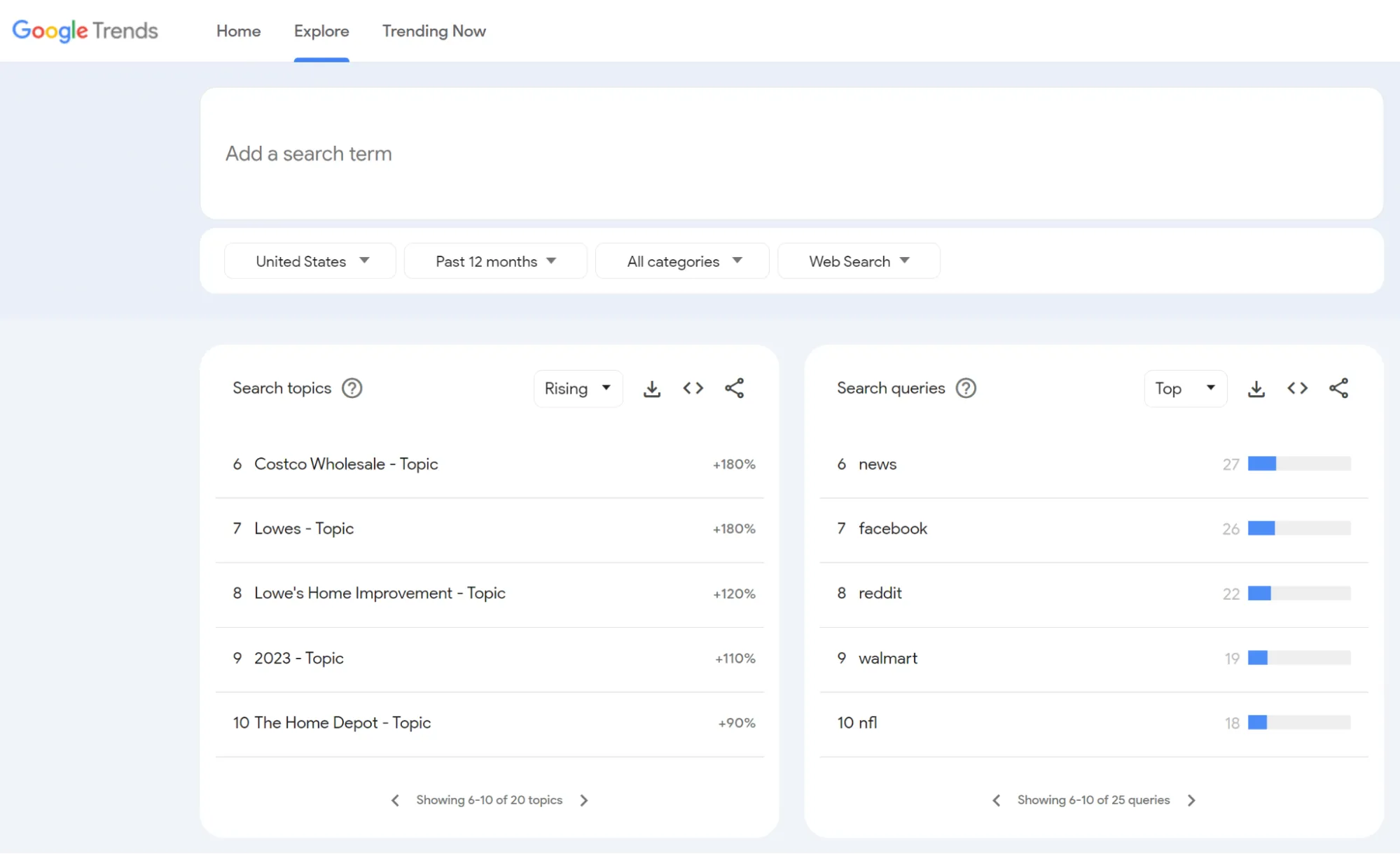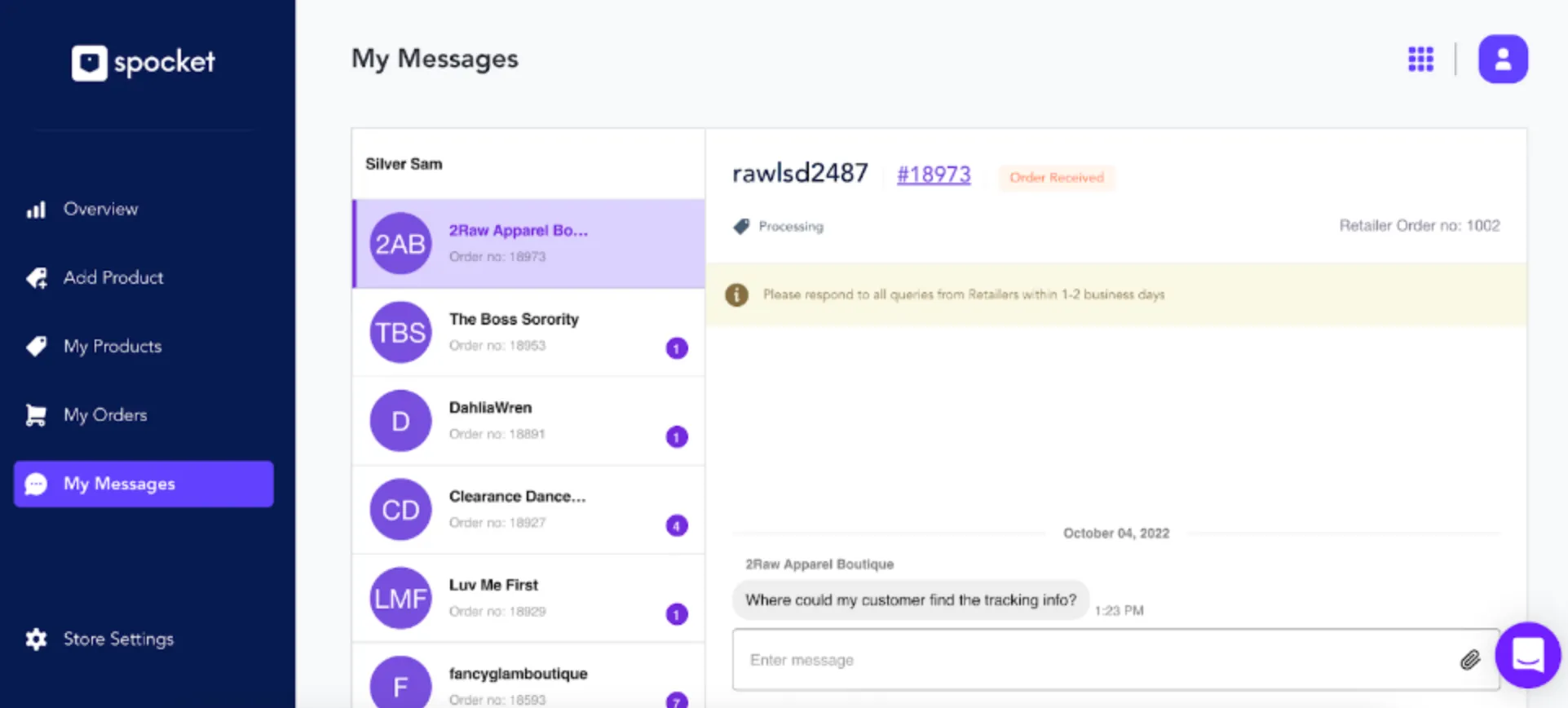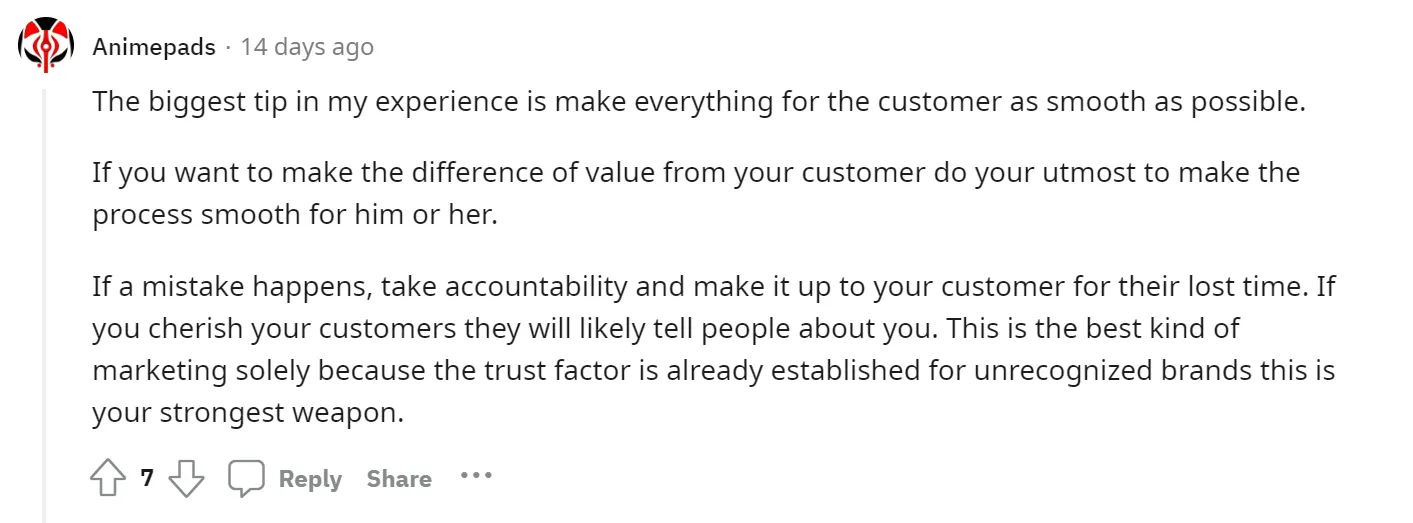Dropshipping is considered by some as a working way out of poverty, but others think that it has too much competition teeming with pitfalls. However, in the face of such conflicting views about what is dropshipping, one fact remains true: it is growing at exponential rates.
The opportunity of taking part of this huge money amount seems appealing, both for experienced sellers and complete beginners in online trading.
However, you should not just go rushing into a dropshipping small business: there are some serious downsides and risks as well. What is dropshipping, and how exactly does it work? Is it a viable business venture for you, or are the risks too high?
What Is Dropshipping?
Think about it: The estimated size of the global dropshipping market was $243.42 billion in 2023, proving how attractive it has become. Nevertheless, one cannot believe the estimated value for the year 2026, which is set at a staggering $476 billion.
Yes, you read that right – nearly half a trillion dollars.
Entrepreneurs in the ever-changing e-commerce sector are always looking for fresh strategies that can help them create and keep profitable businesses online. Dropshipping is one of those emerging approaches. It looks like a low-risk, low-cost avenue to online retail.
Think about the usual way of creating an online store; it involves finding goods, controlling how much is available, and then ensuring that everything is delivered to the customers who made a purchase. These are quite difficult and risky financial burdens – one would’ve had to process everything at their own risk or tie up substantial amounts of money in goods that may not sell.
And that’s where dropshipping provides a compelling alternative. With dropshipping, entrepreneurs do not have to go through the trouble of producing goods themselves or pouring huge amounts of money into buying stock upfront.
Instead, they work with a third party supplier who maintains stock of a wide array of products to sell. Entrepreneurs collaborate with suppliers to select commodities from their vast inventory, some of which will be advertised and sold through the entrepreneurs’ online stores.
How Does Dropshipping Work?
The dropshipping business model is based on a simple yet innovative idea that has completely changed the process of selling products conventionally. Fundamentally, dropshipping simplifies bringing products to market by eliminating the need for inventory management and shipping logistics on the part of the retailer.
Once a client makes an order through the e-commerce platform, the retailer sends the customer’s details and order particulars to the manufacturer or supplier. In turn, the supplier fulfills the order by packaging and shipping the product directly to the customer, hence the name – drop shipping.
Through this, it eliminates the requirement to keep stock or deal with the shipping process – being an efficient and cost-effective fulfillment method.
Key Players in the Dropshipping Model
Retailers (Dropshippers)
Retailers are the driving force behind dropshipping businesses. They create online storefronts, curate product selections, and manage customer relationships.
Retailers must effectively market their products, optimize pricing strategies, and provide exceptional customer service to thrive in the highly competitive e-commerce landscape.
Suppliers (Manufacturers/Wholesalers)
Suppliers and manufacturers play a pivotal role in supply chains by providing a wide range of products for retailers to sell. These entities handle product sourcing, inventory management, and order fulfillment.
Establishing strong partnerships with reliable dropshipping suppliers is essential for retailers to ensure timely delivery and product quality.
Step-by-Step Breakdown: What Is Dropshipping Process
Dropshipping allows entrepreneurs to sell products without holding inventory, as suppliers fulfill orders directly to customers. However, navigating the dropshipping process requires careful planning and execution. Here’s a comprehensive breakdown of each step involved in starting a dropshipping business:
Selection of Dropshipping Products and Suppliers
Begin by identifying a niche market or products with high demand and low competition. Conduct thorough market research using tools like Google Trends, Amazon Best Sellers, or social media insights. Think of other nuances like working with private label or white label goods.
Here’s how you can pinpoint products with high potential for sales with Google Trends:
- Choose products that align with your niche and have a sufficient profit margin.
- Look for items that are lightweight, easy to ship, and not readily available in local stores.
- Research and vet potential suppliers thoroughly.
- Consider factors like product quality, shipping times, customer service, and return policies. Popular platforms like AliExpress, Oberlo, or SaleHoo can help find reliable suppliers.
Setting Up an Online Dropshipping Store
Visit different electronic commerce platforms until you find the most appropriate one for your needs.
Make changes to the way your shop looks and is identified i. e. theme, layout, branding, so that you have an attractive and professional front store. Ensure that there is ease in navigation; also, the products should have clear pictures and interesting descriptions.
Shopify, for instance, has a user-friendly interface and extensive range of customizable themes:
Ensure to also install dropshipping apps or plugins that work well with your selected platform. Such tools take care of timely delivery, as well as availability monitoring through seamless updating of goods data within the integrated system of your online shop.
Customer Orders and Payment Processing
Your supplier will get the order details automatically from the dropshipping app as soon as a client buys from you via the site. For example, AutoDS’s automated order management system ensures prompt order processing, reducing the manual workload.
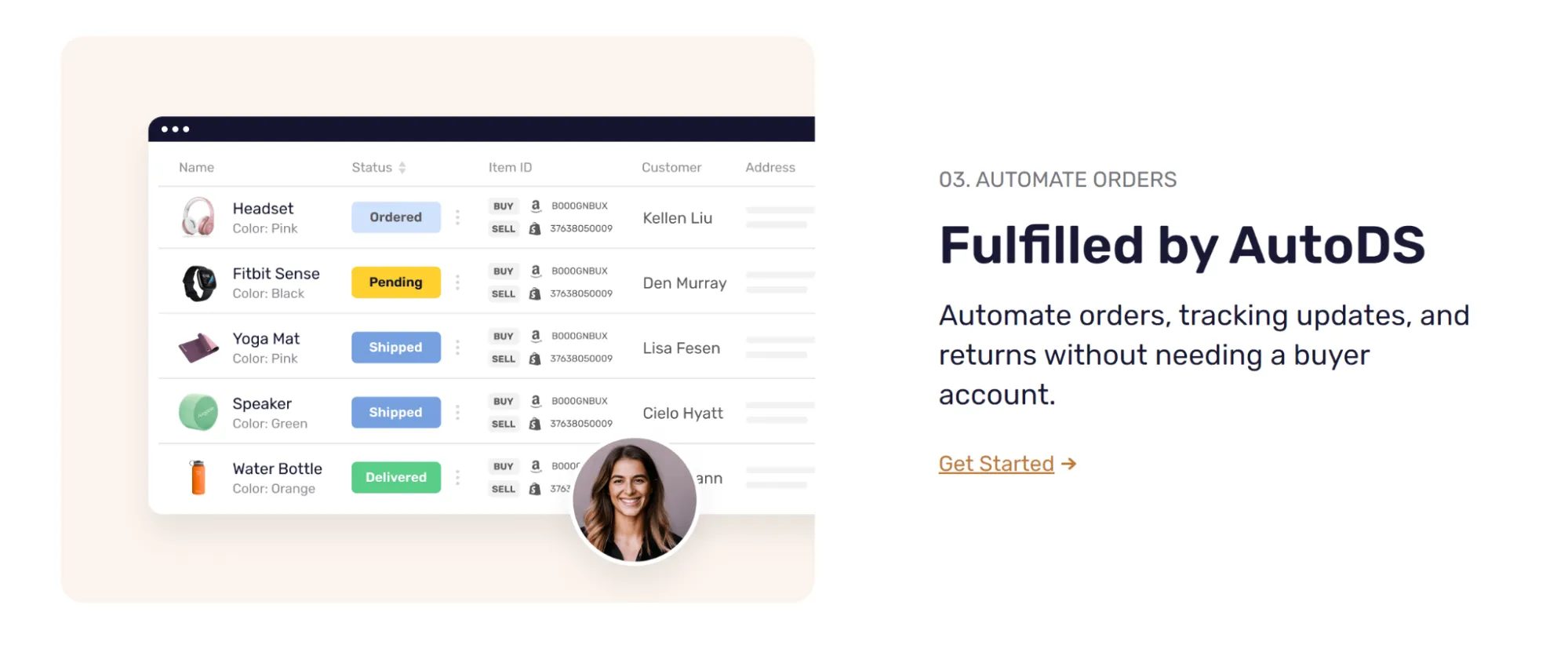 Take payments from clients using any of the available payment gateways. Make certain that you have safe and smooth transactions so as to develop confidence among clients.
Take payments from clients using any of the available payment gateways. Make certain that you have safe and smooth transactions so as to develop confidence among clients.
Provide tracking details so that clients can know where their orders are at. In most cases, customers can take advantage of the order tracking function provided by the majority of drop shipping applications to see how their packages are progressing in real-time.
Communication with Suppliers for Order Fulfillment
The supplier gets a notification via the dropshipping app/ platform as soon as they receive the order. After this, the supplier packages the order and ships it to the client immediately. With tools like Spocket, seamless communication with sellers regarding product inquiries, shipping details, and more is ensured.
Keep communication open with suppliers so that orders can be processed without any problems. Act quickly on any concerns, including availability of products, shipping delays, or poor quality.
Put in place quality control measures aimed at monitoring product quality and guaranteeing customer satisfaction. Seek for product samples from suppliers, carry out inspections, and deal with defects and damaged items.
Is Dropshipping Right for You?
The popularity of dropshipping has increased because it attracts entrepreneurs with promises of low upfront costs and minimal inventory management. However, amidst the allure of easy entry into e-commerce, the question remains: Is dropshipping right for you?
Although it may seem interesting, success in this business model demands careful consideration and strategic planning, so let’s explore the advantages and disadvantages first.

Advantages of Dropshipping
- Low Initial Investment: One of the most significant advantages of dropshipping is its low barrier to entry. Unlike traditional retail models that require substantial capital for inventory purchases and warehousing, dropshipping allows you to start selling products online with minimal upfront investment.
- No Need for Inventory Management: With drop shipping, you don’t have to deal with the complexities of managing inventory. You simply list products from suppliers on your online store and fulfill orders as they come in. This eliminates the need for storage space and reduces the risk of holding onto unsold inventory.
- Flexibility: Dropshipping offers flexibility in terms of the range of products you can offer without the constraints of physical inventory.
- Scalability: As your business grows, you can easily scale up by adding more products or expanding into new markets without the logistical challenges associated with traditional retail.
- Location Independence: Since dropshipping is primarily an online business, you can operate it from anywhere with an internet connection. This flexibility appeals to those seeking a lifestyle business or those who value location independence.
The last point about location has certain downsides and nuances on its own. For example, digital nomads and dropshippers often face a drop in sales or account blocks for logging in from other countries simply because marketplaces and payment platforms don’t fully allow it.
Read on to see how to protect your business accounts from location restrictions with GoLogin.
Disadvantages of Dropshipping
- Lower Profit Margins: While dropshipping requires less upfront investment, it often comes with lower profit margins compared to traditional retail models. Since you’re buying products from suppliers at wholesale prices and selling them at retail prices, your margins can be slim, especially after factoring in expenses such as marketing and transaction fees.
- Dependence on Suppliers: Your success in dropshipping is heavily reliant on your suppliers’ reliability and efficiency. Issues such as stockouts, shipping delays, or product quality problems on the supplier’s end can directly impact your business reputation and customer satisfaction.
- Increased Competition: The accessibility of dropshipping means that competition in certain niches can be fierce. You’ll likely encounter numerous competitors selling similar products, which can make it challenging to stand out and attract customers.
- Limited Control over Fulfillment: Since you’re not managing inventory or shipping products, you have limited control over the fulfillment process. This can lead to challenges in ensuring timely delivery, quality packaging, and consistent customer service experiences.
It is important to consider the advantages and disadvantages of dropshipping and evaluate if it fits into your goals, resources, and risk tolerance. Although making plans and working hard can make dropshipping turn out to be very profitable, this only comes with continued effort aimed at customer satisfaction which itself demands a lot of attention and care.
Tips for Success in Dropshipping
Niche Selection
Starting a dropshipping business successfully requires niche selection before everything else. It involves identifying a market segment with high demand and low competition, as well as aligning with your interests and expertise. A great example of such a niche is POD, or print on demand.
Here’s how to approach niche selection effectively:
- Passion and Profits: Select a niche that you are passionate about and has the potential for profitability.
- Market Research: Conduct thorough research to understand niche trends, customer preferences, and competitive landscape.
- Evaluate Profitability: Analyze the profit margins of potential products within your chosen niche to ensure viability.
Supplier Vetting
Finding reliable suppliers is essential for maintaining product quality, timely delivery, and customer satisfaction. Here are key considerations for vetting suppliers:
- Reliability and Reputation: Partner with suppliers known for reliability, quality products, and efficient shipping.
- Sample Testing: Request samples to assess product quality and supplier reliability firsthand.
- Communication Channels: Establish clear communication channels with suppliers to address any issues promptly.
Optimized Website
Your website serves as the storefront for your dropshipping business, so it needs to be user-friendly and optimized for conversions. Here’s what you need to focus on:
- User-friendly Design: Create a visually appealing and easy-to-navigate website.
- Clear Product Descriptions: Craft compelling product descriptions with high-quality images.
- Streamlined Checkout Process: Make the checkout process easy for customers so that they won’t abandon their shopping carts.
Customer Experience Focus
- Delivering exceptional customer experiences is key to fostering loyalty and driving repeat purchases. Here’s how to prioritize customer satisfaction:
- Responsive Customer Support: Offer prompt and helpful customer support across multiple channels.
- Customization: Create a purchasing process that matches different customer preferences.
- Post-Purchase Engagement: Stay connected with customers post-purchase to gather feedback and encourage repeat business.
Effective Marketing Strategies
To drive traffic and generate sales, you need robust marketing strategies tailored to your target audience. Here’s how to market your dropshipping business effectively:
- Social Media Marketing: Leverage platforms like Facebook, Instagram, and Pinterest to engage with your audience.
- Search Engine Optimization (SEO): Enhance website visibility by optimizing it for search engines.
- Email Marketing: Build an email list and send targeted campaigns to nurture customer relationships.
Consider Using Multiple Accounts With GoLogin
As you scale your dropshipping business, one effective strategy is to create multiple seller accounts to segment products, diversify risks, and expand your reach on platforms like Ebay, Amazon, Shopify, and Etsy.
GoLogin offers invaluable support for managing multiple accounts seamlessly with features such as built-in proxies, safe employee management and continued sessions without entering credentials every day.

Here’s how GoLogin helps dropshippers around the world:
- Complete Account Protection: Manage multiple seller accounts securely with easy UI, proxy and team management.
- Employee Access Control: Customize access levels for each team member to safely share workload on seller accounts without sharing passwords.
- Ban Protection: Protect your work from sudden bans or geo-restrictions with advanced device fingerprint protection system.
- Sales Drop Protection: Your accounts are safely kept in one location: platforms do not see you travel around the world.
GoLogin is one of the most well-known and trusted multi-accounting browsers (check with review platforms if in doubt). It requires no technical skills while having very responsive customer support. Try it on a 7-day free trial! GoLogin is available for Windows, Mac, Android, Linux and as a web app.
Download GoLogin for free and manage multiple accounts without bans!
